Abstract
Gd4Co3 is a promising magnetocaloric material with a high magnetic entropy value. However, it undergoes a first-order magnetic transition, which hinders practical applications. Hence, (Gd4Co3)100−xGex (x = 5, 10, 15) were studied to obtain high magnetic entropy values and a second-order magnetic transition. To investigate the effects of Ge addition on the thermal stability, magnetocaloric properties, and critical behavior of Gd4Co3-based alloys, (Gd4Co3)100−xGex (x = 5, 10, 15) melt spun ribbons were prepared. Phase analysis showed these alloys are mainly amorphous, with a minority nanocrystalline phase. All alloys undergo a second-order ferromagnetic-to-paramagnetic transition. The Curie temperature (TC) increases linearly from 211 K (x = 5) to 217 K (x = 15) with increasing Ge content. Under a magnetic field variation of 5 T, the alloys with x = 5, 10, and 15 exhibit peak magnetic entropy change (−ΔSM) values of 7.15, 6.83, and 6.71 J/(kg·K), respectively, along with considerable refrigerant capacity (RC) in the range of 435–458 J/kg. These excellent magnetocaloric properties collectively demonstrate their great potential for magnetic refrigeration applications. Critical behavior analysis revealed critical exponents broadly consistent with mean-field theory (MFT, β = 0.5, γ = 1.0, δ = 3.0), indicating nanocrystals in the amorphous matrix induce long-range magnetic interactions.
1. Introduction
Driven by the demand for high energy efficiency and environmental protection, magnetic refrigeration (MR), with the magnetocaloric effect (MCE) as its core principle, has demonstrated great potential to replace conventional gas-compression refrigeration [,,,,,]. Since the discovery of the giant MCE in Gd5Si2Ge2 [], extensive efforts have been dedicated to investigating magnetocaloric materials (MCMs) with large or giant MCEs. However, MCMs associated with first-order magnetic transition (FOMT)—such as GdSiGe [,,], MnAsSb [], MnFePX(X = As, Si) [,], and NiMnX (X = Ga, In, Sn)-based Heusler alloys [,,,,]—exhibit a giant magnetic entropy change (−ΔSM) only over a narrow temperature range. Furthermore, significant thermal and magnetic hysteresis losses are commonly encountered in such FOMT alloys, leading to increased energy consumption and thereby impeding their practical application in refrigerator design [].
For second-order magnetic transition (SOMT) magnetocaloric materials, the curves of (−ΔSM) versus temperature (T) exhibit a peak around the transition point and a typical gentle “λ” shape. This λ-shaped profile broadens the transition temperature range, thereby contributing to a large refrigeration capacity (RC). As SOMT materials, amorphous alloys possess several superior properties compared to their crystalline counterparts, including unusually high electrical resistivity, low eddy current losses, high thermal conductivity, excellent corrosion resistance, and tunable magnetic ordering temperature. Additionally, they exhibit negligible thermal and magnetic hysteresis losses, which are favorable characteristics for magnetic cooling []. Although amorphous alloys typically show a smaller peak value of (−ΔSM), their broader (−ΔSM) peak width effectively enhances RC. These advantages make amorphous alloys—especially Gd-based amorphous alloys such as Gd65Mn35−xGex [], Gd60Co30Al10 [], Gd60Co40−xMnx [], Gd55Co35M10 (M = Mn, Fe and Ni) [], (Gd60Al20Co20)100−xNix (x = 0, 1, 3, 5, 7, in at%) [], and RE2Co (RE = Gd, Ho) []—promising candidates for magnetic cooling applications.
Recently, Gd-Co-based amorphous alloys with good glass-forming ability (GFA) have received considerable attention. Gd-Co compounds exhibit strong magnetic exchange coupling, which arises from Ruderman–Kittel–Kasuya–Yosida (RKKY) interactions between Gd atoms via conduction electrons []. For binary Gd-Co glassy ribbons, an increase in Co content relative to Gd leads to a higher Curie temperature (TC), but at the cost of a decreased magnetic entropy change (−ΔSM) [].
With respect to the crystalline Gd4Co3 alloy, earlier studies have revealed two successive magnetic entropy changes. The first change is brought about by a spin-reorientation transition (SRT) at TSR = 163 K, and the second by a transition from ferrimagnetic (FI) to paramagnetic (PM) at TC = 220 K [,]. This double-peak feature in the (−ΔSM) − T curve—attributed to the successive occurrence of TSR and TC—gives rise to an extraordinarily broad temperature range and a significant combined magnetocaloric effect (MCE) [].
Zhang et al. [] recently reported that, for the amorphous Gd4Co3 alloy under a magnetic field change of ΔH = 5 T, the Curie temperature (TC) and the maximum magnetic entropy change (−ΔSM)max correspond to 208 K and 7.2 J/(kg·K), respectively. Previous reports [,] have shown that alloying with B or Si induces a ferromagnetic (FM) to PM transition at the TC. For (Gd4Co3)100−xBx (x = 0, 5, 10, 15) amorphous alloys, increasing B content decreases TC from 215 K to 197 K, while (−ΔSM)max increases from 6.7 J/(kg·K) to 7.8 J/(kg·K) (ΔH = 5 T) []. In contrast, for (Gd4Co3)100−xSix glassy ribbons, Si addition initially lowers TC (to 198 K at x = 0.05) but subsequently increases it substantially (to 213 K at x = 0.1). Under ΔH = 5 T, the (−ΔSM)max values for x = 0, 0.05, and 0.10 are 7.3, 7.2, and 6.4 J/(kg·K), respectively [].
Notably, Si and Ge belong to the same group (Group 14) in the periodic table. As a Group 14 element, germanium (Ge) shares the same valence electron configuration (ns2np2) with silicon (Si)—a well-documented dopant in Gd-based magnetocaloric materials (MCMs). However, Ge has a larger atomic radius (122 pm) than Si (111 pm); importantly, this radius also differs from that of Co (116 pm), a key constituent of the Gd4Co3 matrix. This atomic size mismatch, combined with Ge’s distinct electronic structure, is hypothesized to modulate the alloy’s key material properties in a manner different from Si and boron (B)—two elements that have been previously investigated for alloying with Gd4Co3 [,]. Our previous work [,] indicated that a small amount of Ge or Si improves the GFA of the eutectic Gd65Mn35 alloy. For Gd65Mn35−xGex (x = 0, 5, 10) amorphous alloys, slightly higher Ge content increases TC from 180 K to 229 K, along with an increased (−ΔSM)max []. In contrast, the presence of Si has no significant effect on the TC or MCE of Gd65Mn35−xSix (x = 5, 10) amorphous alloys [].
It is worth noting that while Si and Ge belong to the same group (i.e., are group homologs), the differences in their atomic radii and the respective electronic effects they exert on Gd-based amorphous alloys have not been systematically examined for the Gd4Co3 system. Existing literature lacks data on how Ge substitution impacts the thermal stability, MCE, and critical behavior (e.g., critical exponents governing ferromagnetic-to-paramagnetic transitions) of amorphous Gd4Co3. Thus, in this work, we studied the thermal stability, magnetic properties, and MCE of Ge-added Gd4Co3 rapidly quenched alloys. Additionally, the nature of the FM-to-PM phase transition was determined by analyzing the critical exponents.
2. Materials and Methods
Ingots of (Gd4Co3)100−xGex (x = 5, 10, and 15) alloys were fabricated via arc melting, using high-purity elemental Gd (99.95 wt%), Co (99.995 wt%), and Ge (99.999 wt%) as raw materials under a high-purity argon protective atmosphere. To ensure compositional homogeneity, each ingot was remelted multiple times. The weight loss during arc melting was less than 1.0 wt%, indicating minimal compositional deviation. Subsequently, the ingots were crushed into small pieces, which were then processed into ribbons through single-roller melt spinning—with the process utilizing a copper wheel operating at a rotational speed of 50 m/s.
X-ray diffraction (XRD) was utilized to characterize the phase structure of the melt-spun ribbons, using an X-ray diffractometer (XRD, Philips X’pert Pro MPD, Panalytical, Almelo, The Netherlands) that operated with Cu-Kα1 radiation (λ = 1.54056 Å). Magnetic properties were measured using a physical properties measurement system (PPMS-9, Quantum Design, San Diego, CA, USA) in DC mode. For DC magnetic measurements, the temperature (T) dependence of magnetization (M) was recorded under an applied magnetic field of 0.01 T. The Curie temperature (TC) of each alloy was determined as the temperature that corresponds to the peak value in the curves of |dM/dT| versus T. For the (Gd4Co3)100−xGex rapidly quenched alloys, the temperature dependence of magnetic entropy change (−ΔSM) was calculated from the magnetization isotherms measured near TC, with the calculation following the Maxwell relation []:
where in T refers to the absolute temperature and H denotes the applied magnetic field.
For the study of critical exponents, magnetization (M) versus magnetic field (H) curves of the melt-spun ribbons were measured. The measurements spanned a temperature range of TC ± 20 K, with a 1 K interval maintained between consecutive data points.
The uncertainties of the Curie temperature (TC), crystallization onset temperature (Tx), magnetic entropy change (ΔSM), and critical exponents in this work can be found in Supplementary Materials (Supplementary Data).
3. Results and Discussion
As shown in Figure 1, the XRD patterns of the as-spun (Gd4Co3)100−xGex (x = 5, 10, 15) alloys exhibit clear broad humps—a characteristic feature of the amorphous phase—confirming that the alloys are predominantly amorphous. Nevertheless, weak diffraction peaks corresponding to crystalline Gd4Co3 are also detected, revealing that nanocrystals with a hexagonal Ho4Co3-type crystal structure (space group P63/m) precipitated in the amorphous matrix during the melt-spinning process.
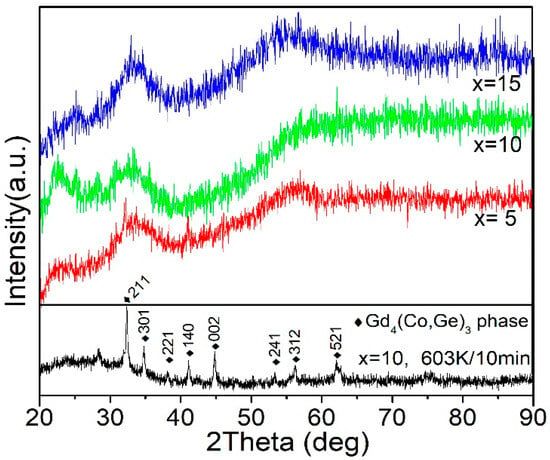
Figure 1.
X-ray diffraction (XRD) patterns of as-spun (Gd4Co3)100−xGex ribbons (x = 5, 10, 15).
As presented in Figure 2, all the DSC curves of the as-spun (Gd4Co3)100−xGex alloys (x = 5, 10, 15) show an exothermic peak in the 550–650 K range, which corresponds to the crystallization of the Ho4Co3-type phase. This assignment is verified by the XRD pattern of an initially amorphous (Gd4Co3)90B10 ribbon after annealing at 603 K for 10 min []. Notably, the crystallization onset temperature (Tx) of the alloys increases with Ge content: ~564 K for x = 5, ~582 K for x = 10, and ~603 K for x = 15. This upward trend in Tx confirms that the as-spun ribbons maintain excellent thermal stability at room temperature.
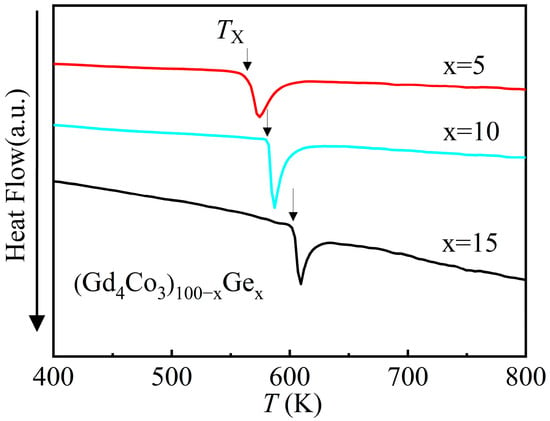
Figure 2.
DSC curves of as-spun (Gd4Co3)100−xGex (x = 5, 10, 15) ribbons (Heating rate: 20 K/min).
To analyze the magnetic properties of the as-spun (Gd4Co3)100−xGex ribbons, their magnetization changes were tested in the temperature range of 5–300 K, and the corresponding M–T curves are displayed in Figure 3. Upon heating, a sharp drop in magnetization is detected—a hallmark of the ferromagnetic (FM) to paramagnetic (PM) phase transition. For the alloys where x = 5, 10, and 15, the corresponding Curie temperatures (TC) are determined to be 211, 215, and 217 K, respectively. Notably, TC exhibits an almost linear increase with higher Ge content, as illustrated in the inset of Figure 3. This trend aligns well with the behavior previously observed in Gd65Mn35−xGex (x = 5, 10) alloys [].
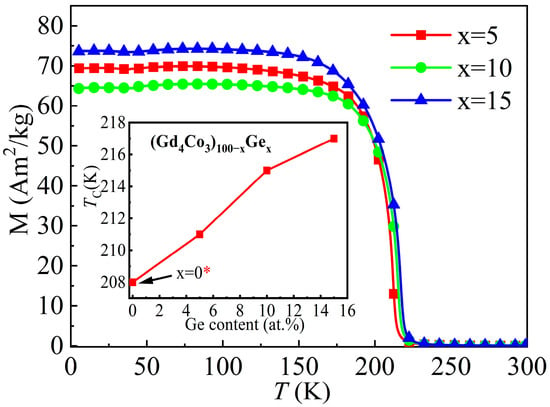
Figure 3.
Temperature dependence of magnetization (M–T) for as-spun (Gd4Co3)100−xGex (x = 5, 10, 15) ribbons measured at an applied field of 0.01 T. The inset shows the dependence of Curie temperature (TC) on Ge content for the as-spun ribbons; the value for x = 0 is adapted from Ref. []. Here, the red * denotes that x = 0 corresponds to the parent compound Gd4Co3 without Ge doping, which serves as a reference for the phase transition temperature.
Figure 4 presents the isothermal magnetization (M–H) curves of the as-spun (Gd4Co3)100−xGex ribbons measured at 5 K with the applied field increasing from 0 to 5 T. All alloys reach magnetic saturation at low fields. The saturation magnetization (MS) values, obtained by extrapolating the high-field magnetization data to zero field, are 188.4, 189.4, and 184.7 A·m2/kg for x = 5, 10, and 15, respectively—corresponding to 3.71, 3.55, and 3.29 μB per magnetic atom. The calculated magnetic moments per Gd atom are 6.83, 6.91, and 6.76 μB/Gd, respectively, which are slightly lower than the experimental MS of the free Gd3+ ion (7.55 μB) []. This reduction is attributed to antiparallel spin coupling in the secondary Gd–Co sublattice [].
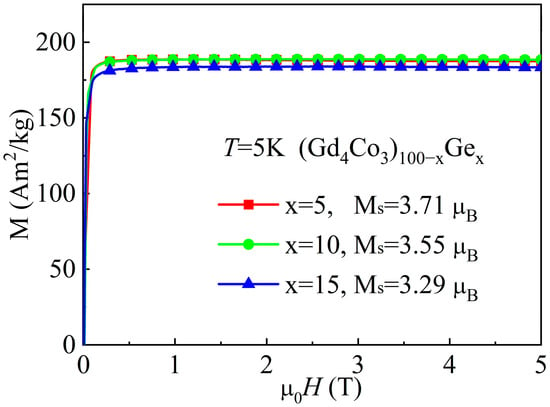
Figure 4.
Isothermal magnetization (M–H) curves of as-spun (Gd4Co3)100−xGex (x = 5, 10 and 15) ribbons measured at 5 K (0–5 T field range).
The (−ΔSM) vs. T curves of the as-spun (Gd4Co3)100−xGex (x = 5, 10, 15) ribbons are presented in Figure 5 and summarized in Table 1. The peak (−ΔSM) values for a field change from 0 to 5 T are 7.2, 6.8 and 6.7 J/(kg·K) for x = 5, 10 and 15, respectively—slightly lower than those for the amorphous Gd4Co3 alloy (7.2 J/(kg·K), 0–5 T) [] and the amorphous (Gd4Co3)90B10 alloy (7.4 J/(kg·K), 0–5 T) []. However, these values are larger than those of the Gd65Fe20Al15−xSix (x = 1, 3, 5, 7) glassy ribbons (4.68~4.80 J/(kg·K), 0–5 T) in a similar temperature range []. The large magnetocaloric effect makes the (Gd4Co3)100−xGex (x = 5, 10, 15) amorphous alloys promising for magnetic cooling applications near 210 K.
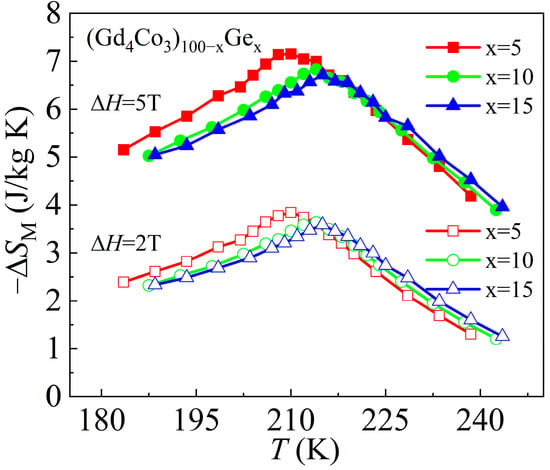
Figure 5.
(−ΔSM) vs. T curves of as-spun (Gd4Co3)100−xGex (x = 5, 10, 15) ribbons for magnetic field changes of 0–2 T and 0–5 T.

Table 1.
Magnetocaloric performances and corresponding parameters of different materials under an applied magnetic field (H), with A denoting amorphous state and C crystalline state.
The value of (−ΔSM) is not the only parameter for characterizing magnetocaloric properties. Refrigeration capacity (RC) is another key quality factor for such materials when used as coolants in magnetic refrigeration, and its values were calculated following the method reported in Ref. [].
Typically, Thot and Tcold are determined as the temperatures on either side of the half-maximum value of (−ΔSM)max.
For a 5 T field change, the as-spun (Gd4Co3)100−xGex ribbons (x = 5, 10, 15) exhibit RC values of 448, 435, and 458 J/kg, respectively. These values are far lower than those of Gd65Fe20Al15−xSix glassy ribbons in a similar temperature range []. However, they are comparable to or even larger than that of La(Fe0.88Si0.12)13 under the same temperature condition [] (Table 1). Combined with their large (−ΔSM) values and high thermal stability, the relatively large RC of the as-spun (Gd4Co3)100−xGex ribbons (x = 5, 10, 15) demonstrates their potential for magnetic cooling at ~210 K.
For the purpose of clarifying the magnetic phase transition mechanism in the as-spun (Gd4Co3)90Ge10 alloy, Arrott plots (M2 vs. μ0H/M) of the as-spun ribbon were constructed using M(H) isotherms measured over TC ± 20 K with a 1 K temperature step (Figure 6). According to the Banerjee criterion [], the presence of a positive slope in the Arrott plot confirms a second-order ferromagnetic (FM) to paramagnetic (PM) phase transition.
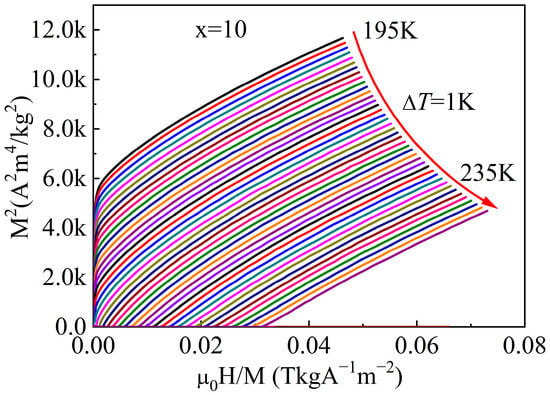
Figure 6.
Arrott plots (M2 vs. μ0H/M) of as-spun (Gd4Co3)90Ge10 ribbon.
For such second-order magnetic transitions (SOMTs), a set of critical exponents is typically used for characterization [,,]: β (describing the temperature dependence of spontaneous magnetization MS), γ (characterizing the inverse initial susceptibility χ−1), and δ (relating to the critical magnetization isotherm at T = TC).
These critical exponents are defined as follows:
Here, t represents the reduced temperature defined as t = 1 − T/TC, while m0, h0 and D stand for critical amplitudes. Critical exponents, which can be derived from experimental measurements, satisfy the Widom scaling relation: δ = 1 + γ/β.
To obtain the critical exponents, the Kouvel–Fisher (KF) method [,] was applied (see Equations (6) and (7)). The advantage of the KF method is that no prior knowledge of TC is required. In addition, only three free parameters need to be determined.
According to the mean-field theory [], Arrott plots should consist of a series of parallel straight lines in the vicinity of TC and pass through the origin at T = TC. To construct such lines, modified Arrott plots (MAPs; see Equation (8)), which are based on the Arrott–Noakes equation of state [], were employed. For the analysis, only the high-field linear region was adopted, since low-field plots show slight curvature caused by mutually misaligned magnetic domains [].
The MAPs are reconstructed by starting from an initial estimate of the critical exponents β and γ, a process that ensures the MAPs yield straight lines.
By performing linear extrapolation on the high-field regions of the MAPs, the spontaneous magnetization MS(T) (plotted on the M1/β axis) and inverse initial susceptibility χ0−1(T) (plotted on the (H/M)1/γ axis) were obtained. These values were then used in conjunction with Equations (6) and (7) to obtain improved estimates of the critical exponents β and γ. This process was iterated until the exponents converged to stable values, yielding the final MAPs.
Figure 7 presents the final iteration step for the as-spun (Gd4Co3)90Ge10 alloy. Two fitted straight lines are observed, which intersect the abscissa at T = TC with slopes −1/β and 1/γ, respectively. For the alloy with x = 10, the critical exponents were found to be β = 0.446, γ = 1.002, and TC = 218 K; similarly, for x = 15, these values are β = 0.484, γ = 1.109, and TC = 220 K.

Figure 7.
Kouvel–Fisher plots of spontaneous magnetization (MS) and inverse initial magnetic susceptibility (χ0−1) for the as-spun (Gd4Co3)90Ge10 alloy.
Figure 8 displays the modified Arrott plots (MAPs, M1/β vs. (H/M)1/γ) of the as-spun (Gd4Co3)90Ge10 alloy, constructed using the critical exponents β = 0.446 and γ = 1.002. The series of parallel lines confirms the high quality of these MAPs. Furthermore, TC = 218 K is extracted from the line passing through the origin, which is consistent with the result obtained via the Kouvel–Fisher (KF) method (Figure 6). Additionally, the critical exponent was calculated using the Widom scaling relation [,]; for the as-spun alloy ribbons with x = 10 and x = 15, the δ values are 3.247 and 3.292, respectively.
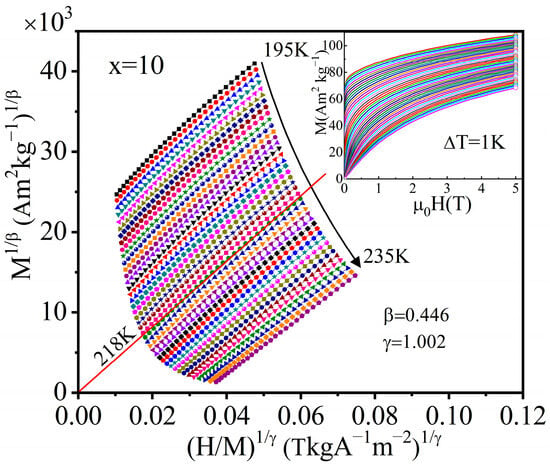
Figure 8.
Modified Arrott plots (M1/β vs (H/M)1/γ) for the as-spun (Gd4Co3)90Ge10 alloy. Solid lines are linear fit to the high-field of the isotherms. The critical isotherm at TC = 218 K passes through the origin.
To further verify the reliability of the acquired critical exponents, scaling theory was employed. As per the scaling hypothesis [], the magnetic equation of state within the critical region can be formulated as:
where the scaling functions f+ and f− correspond to temperatures above (T ˃ TC) and below (T ˂ TC) the critical point, respectively. True scaling behavior implies that all experimental isotherms in the critical region should collapse onto two universal curves (one for T ˃ TC and one for T ˂ TC) when plotted using appropriate scaling variables and with consistent values of β, γ, and δ.
By employing the renormalized magnetization m = t−βM(H,t) and the renormalized field h = Ht−(β+γ), the equation of state (9) transforms to
The scaled plots of m versus h, constructed using the critical exponents β, γ, and δ obtained from the Kouvel–Fisher (KF) method, are presented in Figure 9. On a log-log scale, all data points collapse onto two distinct branches for T > TC and T ˂ TC, confirming the accuracy of the determined critical exponents.
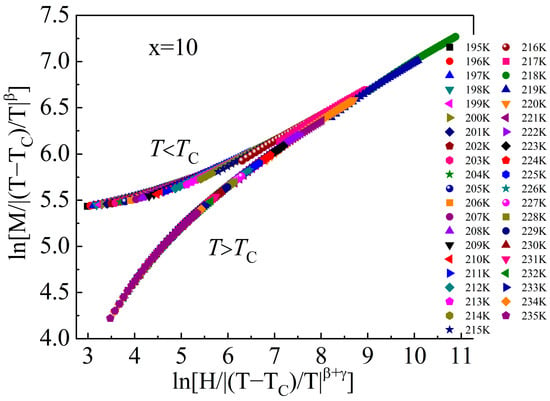
Figure 9.
ln-ln Scaling plots (renormalized m vs. h) of the as-spun (Gd4Co3)90Ge10 alloy in the critical region, with data collapse via β and γ from the KF method.
Table 2 lists the critical exponents derived from the KF method, alongside the theoretically predicted values for different models: mean-field theory (MFT), the three-dimensional Heisenberg (H3D) model, and the three-dimensional Ising (Is3D) model. A key distinction between these models is their underlying magnetic coupling: the H3D and Is3D models are based on short-range magnetic coupling [], while the MFT model is based on long-range magnetic coupling []. Notably, the critical exponents of the alloys are broadly consistent with the MFT-predicted values; this consistency arises from the nanocrystals in the alloys, which generate long-range magnetic coupling.

Table 2.
Comparison of critical exponents β, γ, and δ: KF method-determined values for (Gd4Co3)100−xGex (x = 10, 15) alloys vs. theoretically predicted values for various universal classes.
4. Conclusions
In this work, (Gd4Co3)100−xGex (x = 5, 10, 15) ribbons were fabricated via melt spinning. Phase analysis revealed that all as-spun ribbons are predominantly amorphous, with minor hexagonal Ho4Co3-type (space group P63/m) nanocrystals precipitated in the amorphous matrix during the melt-spinning process. The onset crystallization temperature (Tx) of the alloys increases with Ge content (from 564 K for x = 5 to 603 K for x = 15), demonstrating excellent thermal stability at room temperature.
All alloys undergo a second-order ferromagnetic (FM)-to-paramagnetic (PM) phase transition, with the Curie temperature (TC) increasing linearly with rising Ge content—from 211 K (x = 5) to 215 K (x = 10) and further to 217 K (x = 15). For a 0–5 T field change, the (−ΔSM)max of the (Gd4Co3)100−xGex alloys is 7.15 (x = 5), 6.83 (x = 10), and 6.71 (x = 15) J/(kg·K). These values are slightly lower than the corresponding values for amorphous Gd4Co3 and (Gd4Co3)90B10 but higher than Gd65Fe20Al15−xSix glassy ribbons in the same temperature range. Combined with their large (−ΔSM) values and high thermal stability, the relatively large RC of the as-spun (Gd4Co3)100−xGex ribbons demonstrates their potential in magnetic cooling applications at ~210 K.
Critical behavior analysis was performed using the Kouvel–Fisher (KF) method and Widom’s scaling relation. The critical exponents of the alloys are β = 0.446, γ = 1.002, δ = 3.247 (x = 10) and β = 0.484, γ = 1.109, δ = 3.292 (x = 15), which are generally consistent with the predictions of mean-field theory (MFT, β = 0.5, γ = 1.0, δ = 3.0). This consistency indicates that the nanocrystals in the amorphous matrix induce long-range magnetic interactions.
Overall, the (Gd4Co3)100−xGex amorphous–nanocrystalline ribbons combine favorable thermal stability, a tunable second-order FM-PM transition, and a considerable magnetocaloric effect, rendering them attractive candidates for low-temperature magnetic refrigeration applications.
Supplementary Materials
The following supporting information can be downloaded at: https://www.mdpi.com/article/10.3390/met15111267/s1. Table S1: Summary of uncertainty estimates for critical exponents of the (Gd4Co3)100−xGex (x = 10, 15) alloys.
Author Contributions
Conceptualization, methodology, formal analysis, investigation, funding acquisition, writing—original draft preparation, writing—review and editing, X.Z.; Software, Resources, Validation, Y.W., H.Y. and Z.L. All authors have read and agreed to the published version of the manuscript.
Funding
This work was supported by the National Natural Science Foundation of China (Grant Nos. 52561009, 52066001, 51874143) and the Guangdong Basic and Applied Basic Research Foundation (Grant Nos. 2024A1515011481, 2022A1515012578). This research is also supported by the National Research Foundation, Singapore under its Competitive Research Program grant NRF-CRP29-2022-0002.
Data Availability Statement
The original contributions presented in this study are included in the article/Supplementary Material. Further inquiries can be directed to the corresponding author.
Acknowledgments
All authors are deeply grateful to R. V. Ramanujan for his meticulous assistance in revising this paper—from polishing the logical flow of each section to clarifying ambiguous technical descriptions.
Conflicts of Interest
The authors declare no conflict of interest.
References
- Franco, V.; Blázquez, J.S.; Ipus, J.J.; Law, J.Y.; Moreno-Ramírez, L.M.; Conde, A. Magnetocaloric effect: From materials research to refrigeration devices. Prog. Mater. Sci. 2018, 93, 112–232. [Google Scholar] [CrossRef]
- Li, L.W.; Yan, M. Recent progresses in exploring the rare earth based intermetallic compounds for cryogenic magnetic refrigeration. J. Alloys Compd. 2020, 823, 153810. [Google Scholar] [CrossRef]
- Hou, H.L.; Qian, S.X.; Takeuchi, I. Materials, physics and systems for multicaloric cooling. Nat. Rev. Mater. 2022, 7, 633–652. [Google Scholar] [CrossRef]
- Lucia, U.; Grisolia, G. Magnetocaloric refrigeration in the context of sustainability: A review of thermodynamic bases, the state of the art, and future prospects. Energies 2024, 17, 3585. [Google Scholar] [CrossRef]
- Nehan, P.Z.Z.; Vitayaya, O.; Munazat, D.R.; Manawan, M.T.E.; Darmintod, D.; Kurniawan, B. The magnetocaloric effect properties for potential applications of magnetic refrigerator technology: A review. Phys. Chem. Chem. Phys. 2024, 26, 14476–14504. [Google Scholar] [CrossRef] [PubMed]
- Czernuszewicz, A.; Mudryk, Y.; Cui, J.; Griffith, L.; Johnson, D.D.; Slaughter, J. From the discovery of the giant magnetocaloric effect to the development of high-power-density systems. Adv. Mater. Technol. 2025, e00545. [Google Scholar] [CrossRef]
- Pecharsky, V.K.; Gschneidner, K.A., Jr. Giant magnetocaloric effect in Gd5(Si2Ge2). Phys. Rev. Lett. 1997, 78, 4494–4497. [Google Scholar] [CrossRef]
- Pecharsky, V.K.; Gschneidner, K.A., Jr. Tunable magnetic regenerator alloys with a giant magnetocaloric effect for magnetic refrigeration from similar to 20 to similar to 290 K. Appl. Phys. Lett. 1997, 70, 3299–3301. [Google Scholar] [CrossRef]
- Singh, S.; Liu, N.; Zhang, Y.; Nozariasbmarz, A.; Karan, S.K.; Raman, L.; Goyal, G.K.; Sharma, S.; Li, W.J.; Priya, S.; et al. High-performance thermomagnetic Gd−Si−Ge alloys. ACS Appl. Mater. Interfaces 2023, 15, 35140–35148. [Google Scholar] [CrossRef]
- Wada, H.; Tanabe, Y. Giant magnetocaloric effect of MnAs1−xSbx. Appl. Phys. Lett. 2001, 79, 3302–3304. [Google Scholar] [CrossRef]
- Tegus, O.; Brück, E.; Buschow, K.H.J.; de Boer, F.R. Transition-metal-based magnetic refrigerants for room-temperature applications. Nature 2002, 415, 150–152. [Google Scholar] [CrossRef] [PubMed]
- Quijano, D.P.; Carlos Infante Ferreira, C.I.; Brück, E. Layering strategies for active magnetocaloric regenerators using MnFePSi for heat pump applications. Appl. Therm. Eng. 2023, 232, 120962. [Google Scholar] [CrossRef]
- Liang, L.; Tong, W.; Wang, H.J.; Peng, L.M. Enhancing magnetocaloric properties of NiMnGa-based alloys via Dy micro-alloying and pseudoelastic cyclic training. Appl. Phys. Lett. 2023, 123, 022409. [Google Scholar] [CrossRef]
- Tiwari, N.; Mishra, S.; Sarkar, S.; Talapatra, S.; Palit, M.; Paliwal, M.; Singh, A.K.; Tiwary, C.S. Magnetocaloric effect in Mn-rich Heusler-derived alloys for room temperature-based applications. J. Mater. Chem. C 2025, 13, 10789–10803. [Google Scholar] [CrossRef]
- Xie, Q.; Feng, Y.; Yuan, X.Y.; Liu, Q.W.; Zhou, J.J.; Wang, S.X. Zr-doped Ni-Mn-In alloy: A novel solid-state refrigeration material with enhanced magneto-caloric and elasto-caloric effects. J. Alloys Compd. 2025, 1010, 177765. [Google Scholar] [CrossRef]
- Zhang, Y.; Bai, J.; Guo, K.L.; Liu, D.; Li, Y.S.; Gu, J.L.; Ma, Q.S.; Gao, Q.Z.; Morley, N.; Zou, L. Enhanced magnetocaloric effect in Ni-Mn-Sn alloys by synergistic manipulation of magnetization difference and lattice volume. Appl. Mater. Today 2025, 42, 102589. [Google Scholar] [CrossRef]
- Pérez-Landazábal, J.I.; Recarte, V.; Sánchez-Alarcos, V.; Beato-López, J.J.; Rodríguez-Velamazán, J.A.; Sánchez-Marcos, J.; Gómez-Polo, C.; Cesari, E. Giant direct and inverse magnetocaloric effect linked to the same forward martensitic transformation. Sci. Rep. 2017, 7, 13328. [Google Scholar] [CrossRef]
- Zhang, F.Q.; Westra, K.; Shen, Q.; Batashev, I.; Kiecana, A.; van Dijk, A.; Brück, E. The second-order magnetic phase transition and magnetocaloric effect in all-d-metal NiCoMnTi-based Heusler alloys. J. Alloys Compd. 2022, 906, 164337. [Google Scholar] [CrossRef]
- Zhong, X.C.; Min, J.X.; Zheng, Z.G.; Liu, Z.W.; Zeng, D.C. Critical behavior and magnetocaloric effect of Gd65Mn35−xGex (x=0, 5, and 10) melt-spun ribbons. J. Appl. Phys. 2012, 112, 033903. [Google Scholar] [CrossRef]
- Fu, H.; Zou, M. Magnetic and magnetocaloric properties of ternary Gd-Co-Al bulk metallic glasses. J. Alloys Compd. 2011, 509, 4613–4616. [Google Scholar] [CrossRef]
- Zheng, Z.G.; Zhong, X.C.; Yu, H.Y.; Franco, V.; Liu, Z.W.; Zeng, D.C. The magnetocaloric effect and critical behavior in amorphous Gd60Co40–xMnx alloys. J. Appl. Phys. 2012, 111, 07A922. [Google Scholar] [CrossRef]
- Zhong, X.C.; Huang, X.W.; Shen, X.Y.; Mo, H.Y.; Liu, Z.W. Thermal stability, magnetic properties and large refrigerant capacity of ternary Gd55Co35M10 (M=Mn, Fe and Ni) amorphous alloys. J. Alloys Compd. 2016, 682, 476–480. [Google Scholar] [CrossRef]
- Yao, Y.Y.; Li, Z.; Liu, J.S.; Zhang, M.W.; Zhang, Y.; Wang, F.; Liu, R.; Shen, H.X. Effect of Ni alloying on the microstructure and magnetocaloric properties of Gd-based metallic microffbers. J. Alloys Compd. 2023, 961, 170979. [Google Scholar] [CrossRef]
- Jia, J.B.; Du, Y.S.; Fu, G.; Wu, X.F.; Deng, J.Q.; Cheng, G.; Wang, J.; Zhao, J.T.; Rao, G.H. Manufacture and characterization of RE2Co (RE=Gd, Ho) amorphous alloys with excellent magnetic entropy change. Intermetallics 2024, 167, 108234. [Google Scholar] [CrossRef]
- Tripathy, S.K.; Suresh, K.G.; Nigam, A.K. A comparative study of the magnetocaloric effect in Gd3Co and Gd3Ni. J. Magn. Magn. Mater. 2006, 306, 24–29. [Google Scholar] [CrossRef]
- Zhang, C.L.; Wang, D.H.; Han, Z.D.; Xuan, H.C.; Gu, B.X.; Du, Y.W. Large magnetic entropy changes in Gd-Co amorphous ribbons. J. Appl. Phys. 2009, 105, 013912. [Google Scholar] [CrossRef]
- Seixas, T.M.; Machado da Silva, J.M.; Papageorgiou, T.P.; Braun, H.F.; Eska, G. Spin reorientation transition in Gd4Co3. Phys. B 2004, 353, 34–40. [Google Scholar] [CrossRef]
- Zhang, Q.; Li, B.; Zhao, X.G.; Zhang, Z.D. Magnetic and reversible magnetocaloric properties of (Gd1−xDyx)4Co3 ferrimagnets. J. Appl. Phys. 2009, 105, 053902. [Google Scholar] [CrossRef]
- Zhang, J.L.; Zheng, Z.G.; Cao, W.H.; Shek, C.H. Magnetic behavior of Gd4Co3 metallic glass. J. Magn. Magn. Mater. 2013, 326, 157–161. [Google Scholar] [CrossRef]
- Zhong, X.C.; Gao, B.B.; Liu, Z.W.; Zheng, Z.G.; Zeng, D.C. Amorphous and crystallized (Gd4Co3)100−xBx alloys for magnetic refrigerants working in the vicinity of 200 K. J. Alloys Compd. 2013, 553, 152–156. [Google Scholar] [CrossRef]
- Zheng, Z.G.; Zhong, X.C.; Liu, Z.W.; Zeng, D.C.; Franco, V.; Zhang, J.L. Magnetocaloric effect and critical behavior of amorphous (Gd4Co3)1−xSix alloys. J. Magn. Magn. Mater. 2013, 343, 184–188. [Google Scholar] [CrossRef]
- Min, J.X.; Zhong, X.C.; Liu, Z.W.; Zheng, Z.G.; Zeng, D.C. Magnetic properties and magnetocaloric effects of Gd-Mn-Si ribbons in amorphous and crystalline states. J. Alloys Compd. 2014, 606, 50–54. [Google Scholar] [CrossRef]
- Nigh, H.E.; Legvold, S.; Spedding, F.H. Magnetization and electrical resistivity of gadolinium single crystals. Phys. Rev. 1963, 132, 1092–1097. [Google Scholar] [CrossRef]
- Kaneyoshi, T. Amorphous Magnetism; CRC Press: Boca Raton, FL, USA, 2018. [Google Scholar]
- Zhao, X.G.; Lai, J.H.; Hsieh, C.C.; Fang, Y.K.; Chang, W.C.; Zhang, Z.D. The influence of Si addition on the glass forming ability, magnetic and magnetocaloric properties of the Gd-Fe-Al glassy ribbons. J. Appl. Phys. 2011, 109, 07A911. [Google Scholar] [CrossRef]
- Zhong, X.C.; Tang, P.F.; Liu, Z.W.; Zeng, D.C.; Zheng, Z.G.; Yu, H.Y.; Qiu, W.Q.; Zhang, H.; Ramanujan, R.V. Large magnetocaloric effect and refrigerant capacity in Gd–Co–Ni metallic glasses. J. Appl. Phys. 2012, 111, 07A919. [Google Scholar] [CrossRef]
- Fujita, A.; Fukamichi, K. Control of large magnetocaloric effects in metamagnetic La(FexSi1−x)13 compounds by hydrogenation. J. Alloys Compd. 2005, 404–406, 554–558. [Google Scholar] [CrossRef]
- Banerjee, B.K. On a generalised approach to first and second order magnetic transitions. Phys. Lett. 1964, 12, 16–17. [Google Scholar] [CrossRef]
- Henchiri, C.; Gu, S.X.; Qi, Q.; Zhou, H.S.; Dhahri, E.; Valente, M.A. Study of the structural, magnetic, magnetocaloric properties and critical exponents of La0.9 0.1MnO2.95 compound. Appl. Phys. A 2025, 131, 597. [Google Scholar] [CrossRef]
- Babu, P.D.; Kaul, S.N. Scaling behaviour of magnetization for temperatures in the vicinity of, and far from, the ferromagnetic-paramagnetic phase transition in amorphous Fe90−xCoxZr10 and Fe90+yZr10−y alloys. J. Phys. Condens. Matter 1997, 9, 7189–7222. [Google Scholar] [CrossRef]
- Liu, P.F.; Peng, J.; Xue, M.Q.; Wang, B.S. Magnetocaloric effect and critical behavior of the Mn-rich itinerant material Mn3GaC with enhanced ferromagnetic interaction. Chin. Phys. B 2020, 29, 047503. [Google Scholar] [CrossRef]
- Kouvel, J.S.; Fisher, M.E. Detailed magnetic behavior of nickel near its Curie point. Phys. Rev. 1964, 36, 1626–1632. [Google Scholar] [CrossRef]
- Wang, H.O.; Dong, F.X.; Wang, H.C.; Zhao, B.J.; Wang, Y.; Tan, W.S. Magnetic properties, critical behavior, and magnetocaloric effect of Nd1−xSrxMnO3 (0.2 ≤ x ≤ 0.5): The role of Sr doping concentration. J. Appl. Phys. 2024, 136, 093902. [Google Scholar] [CrossRef]
- Stanley, H.E. (Ed.) Introduction to Phase Transition and Critical Phenomena; Oxford University Press: New York, NY, USA, 1971. [Google Scholar]
- Arrott, A.; Noakes, J.E. Approximate equation of state for nickel near its critical temperature. Phys. Rev. Lett. 1967, 19, 786–789. [Google Scholar] [CrossRef]
- Aharoni, A. Introduction to the Theory of Ferromagnetism; Oxford University Press: New York, NY, USA, 1971. [Google Scholar]
- Widom, B. Degree of the critical isotherm. J. Chem. Phys. 1964, 41, 1633–1634. [Google Scholar] [CrossRef]
- Deng, R.R.; Yu, B.W.; Zheng, H.; Qiu, Y.W.; Wang, S.H.; Ma, C.L.; Wang, C.X.; Zhu, Y.; Fan, J.Y. Magnetic phase transition and critical behavior of the chiral magnet β-Mn type Co7Zn7Mn6. Chem. Phys. Lett. 2024, 856, 141622. [Google Scholar] [CrossRef]
- Stanley, H.E. Scaling, universality, and renormalization: Three pillars of modern critical phenomena. Rev. Mod. Phys. 1999, 71, S358–S366. [Google Scholar] [CrossRef]
- Le Guillou, J.C.; Zinn-Justin, J. Critical exponents from field theory. Phys. Rev. B 1980, 21, 3976–3998. [Google Scholar] [CrossRef]
Disclaimer/Publisher’s Note: The statements, opinions and data contained in all publications are solely those of the individual author(s) and contributor(s) and not of MDPI and/or the editor(s). MDPI and/or the editor(s) disclaim responsibility for any injury to people or property resulting from any ideas, methods, instructions or products referred to in the content. |
© 2025 by the authors. Licensee MDPI, Basel, Switzerland. This article is an open access article distributed under the terms and conditions of the Creative Commons Attribution (CC BY) license (https://creativecommons.org/licenses/by/4.0/).